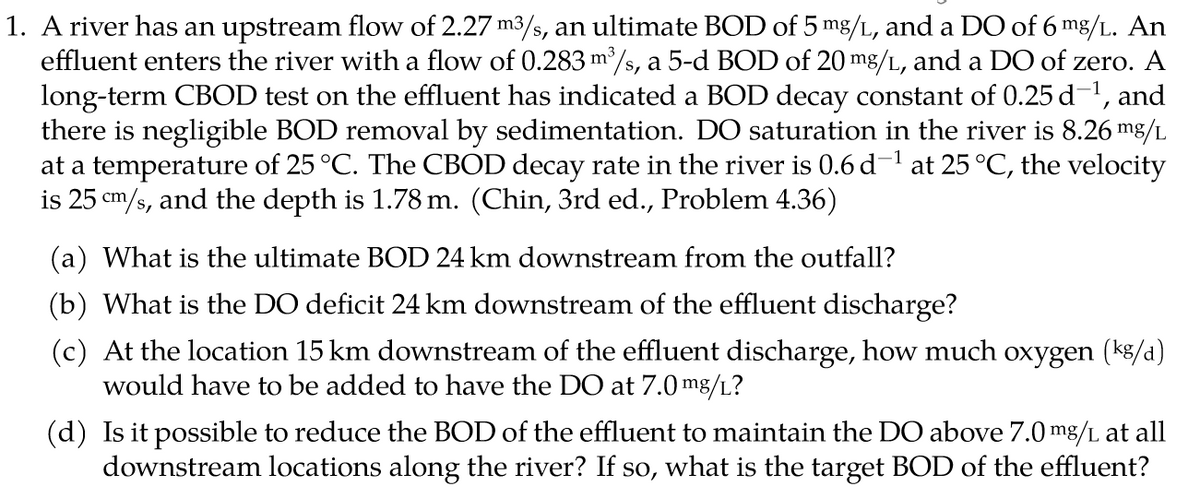Is it possible to reduce the BOD of the effluent to maintain the DO above 7.0 mg/L at all downstream locations along the river? If so, what is the target BOD of the effluent?
Is it possible to reduce the BOD of the effluent to maintain the DO above 7.0 mg/L at all downstream locations along the river? If so, what is the target BOD of the effluent?
Chapter2: Loads On Structures
Section: Chapter Questions
Problem 1P
Related questions
Question
What is the ultimate BOD 24 km downstream from the outfall?
> Answer: 3.89 g/m3
What is the DO deficit 24 km downstream of the effluent discharge?
> Answer: 3.192 g/m3
Question: Is it possible to reduce the BOD of the effluent to maintain the DO above 7.0 mg/L at all downstream locations along the river? If so, what is the target BOD of the effluent?

Transcribed Image Text:1. A river has an upstream flow of 2.27 m3/s, an ultimate BOD of 5 mg/L, and a DO of 6 mg/L. An
effluent enters the river with a flow of 0.283 m/s, a 5-d BOD of 20 mg/L, and a DO of zero. A
long-term CBOD test on the effluent has indicated a BOD decay constant of 0.25 d-1, and
there is negligible BOD removal by sedimentation. DO saturation in the river is 8.26 mg/L
at a temperature of 25 °C. The CBOD decay rate in the river is 0.6 d- at 25 °C, the velocity
is 25 cm/s, and the depth is 1.78 m. (Chin, 3rd ed., Problem 4.36)
(a) What is the ultimate BOD 24 km downstream from the outfall?
(b) What is the DO deficit 24 km downstream of the effluent discharge?
(c) At the location 15 km downstream of the effluent discharge, how much oxygen (k8/a)
would have to be added to have the DO at 7.0 mg/L?
(d) Is it possible to reduce the BOD of the effluent to maintain the DO above 7.0 mg/L at all
downstream locations along the river? If so, what is the target BOD of the effluent?
Expert Solution
Step 1

Step by step
Solved in 2 steps with 2 images

Knowledge Booster
Learn more about
Need a deep-dive on the concept behind this application? Look no further. Learn more about this topic, civil-engineering and related others by exploring similar questions and additional content below.Recommended textbooks for you


Structural Analysis (10th Edition)
Civil Engineering
ISBN:
9780134610672
Author:
Russell C. Hibbeler
Publisher:
PEARSON

Principles of Foundation Engineering (MindTap Cou…
Civil Engineering
ISBN:
9781337705028
Author:
Braja M. Das, Nagaratnam Sivakugan
Publisher:
Cengage Learning


Structural Analysis (10th Edition)
Civil Engineering
ISBN:
9780134610672
Author:
Russell C. Hibbeler
Publisher:
PEARSON

Principles of Foundation Engineering (MindTap Cou…
Civil Engineering
ISBN:
9781337705028
Author:
Braja M. Das, Nagaratnam Sivakugan
Publisher:
Cengage Learning

Fundamentals of Structural Analysis
Civil Engineering
ISBN:
9780073398006
Author:
Kenneth M. Leet Emeritus, Chia-Ming Uang, Joel Lanning
Publisher:
McGraw-Hill Education


Traffic and Highway Engineering
Civil Engineering
ISBN:
9781305156241
Author:
Garber, Nicholas J.
Publisher:
Cengage Learning